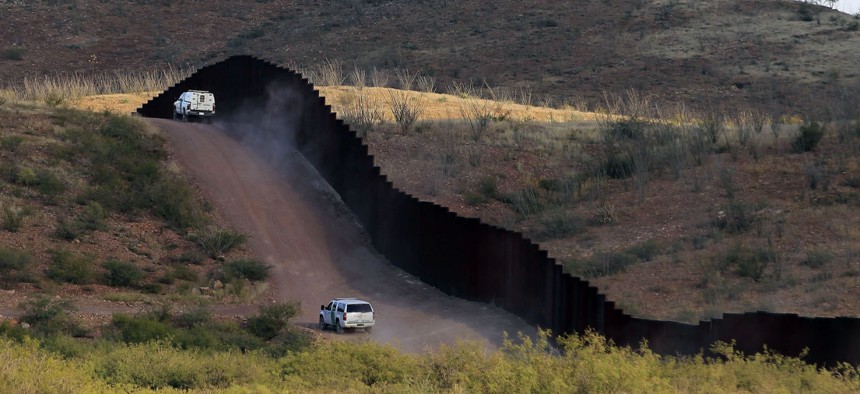
Border Patrol agents patrol near the fence in Naco, Ariz. Ross D. Franklin / AP file photo
Border Agents Say They're 'Woefully Understaffed,' Applaud National Guard Deployment
Previous deployments of the National Guard to the border had drawbacks, auditors have found.
Federal agents on the front lines of the U.S.-Mexico border are “excited” about the forthcoming deployment of the National Guard to assist them in their mission, according to the employees’ union, with officials noting that the extra personnel will help offset their being “woefully understaffed.”
The guardsmen will serve in support and administrative positions, said Brandon Judd, president of the National Border Patrol Council, freeing up Border Patrol agents to go directly to the front lines. The National Guard can fill roles in a control room watching surveillance cameras, monitoring sensors, in skyboxes or scope trucks, Judd said, noting ideas that he has passed up the chain of command at Customs and Border Protection and drawing from his experiences during previous deployments.
“It frees up our resources and allows us to put more agents at the border instead of in support,” said Judd, who has served as a Border Patrol agent for 20 years. “The National Guard is going to be a huge boon especially considering how understaffed we are.”
The Border Patrol is currently operating about 2,000 agents short of its congressionally mandated floor, and efforts to fill vacancies and add to its rolls on top of that level are not going well. In fiscal 2017, the agency actually lost more agents than it brought on. CBP has for the last two years gone to Congress and conceded it required $200 million less in its appropriation for hiring because it could not keep pace with what it had anticipated. This occurred in spite of President Trump’s demands that the agency hire 5,000 new agents.
“It’s absolutely a contributing factor” to the deployment of the guard, Judd said of the hiring woes.
The Trump administration has pointed to an uptick in illegal border crossing to justify the deployment, the details of which are still being worked out with the governors of each state expected to send troops. CBP apprehended or deemed inadmissible more than 50,000 individuals at the Southwest border last month, tripling the total in March of 2017. Last year was unusual, however—the administration has attributed this to a “Trump effect” associated with fewer immigrants looking to cross because of the rhetoric the president used on the campaign trail—and the March 2018 apprehensions are in line with the figures seen in that month in previous years. Apprehensions were down in January compared to 2017, but increased by more than 50 percent in February.
Homeland Security Department Secretary Kristjen Nielsen at a White House briefing this week, however, cited an uptick in the number of unaccompanied children and family units arriving at the border to justify the National Guard deployment.
“The traffickers and smugglers know that if you arrive with a family, under our current legal and court system, you have a much better chance of being released into the United States,” Nielsen said.
Figures from CBP, however, show that unaccompanied children apprehended at the border are on pace to decline by 11 percent. Family unit apprehensions are on pace to drop by more than half. When asked about this discrepancy, DHS spokespeople pointed back to the same numbers.
Judd said Border Patrol agents on the ground have been warning CBP leadership about an overall influx of illegal crossings for months.
“It’s one of my great disappointments and one of my pet peeves,” Judd said. Ever since March of 2017, with limited exception, Judd said, “The numbers kept going up and up and up. We kept said, ‘What are you going to do? What operations are you going to implement? What are you going to do to stem this tide, to stem this flow?’ And nothing happened.”
The union leader said he blames CBP leadership for bringing the agency to the point that the National Guard is necessary.
“We’re always reactive instead of proactive,” he said. “Frankly, this is CBP’s fault.”
Trump on Thursday estimated CBP will welcome between 2,000 and 4,000 guardsmen. That would surpass the 1,200 troops President Obama deployed to the border in 2010 during Operation Phalanx, but fall short of the 6,000 President George W. Bush deployed in Operation Jump Start in 2006. Bush’s initiative cost $1.2 billion over two years and required 30,000 guardsmen to fill the 6,000 slots. The National Guard “assisted in 11.7 percent of all undocumented alien apprehensions and 9.4 percent of all marijuana seized on the Southwest border” during Jump Start, according to the Government Accountability Office. Obama’s push cost $110 million over one year, and the guardsmen assisted in 6 percent of undocumented apprehensions and 3 percent of marijuana seizures.
Guardsmen are statutorily prohibited from personally making arrests and seizures, instead only identifying individuals attempting to enter the country and relaying that information to Border Patrol. This means National Guard patrols require twice as many individuals as those conducted by Border Patrol, according to GAO. National Guard officials have told GAO the deployment of their troops could lead to civilians thinking the border has been militarized and guardsmen receiving surveillance training with diminishing value. It could also hurt future recruitment and retention and limit the Guard's availability for other duties such as disaster assistance. CBP officials have cautioned that temporary duty assignments from the National Guard could impact the agency’s long-term border security planning.
To Judd, the National Guard deployment is a proven method. “I think it will be even more effective this time because we get better and better each time,” he said.
NEXT STORY: How to Serve a President You Don’t Like







